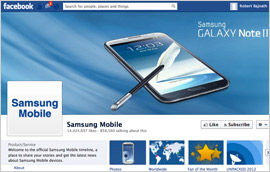 Facebook’s shares shot up Wednesday after it released third-quarter results showing the company was making progress in building its mobile ad
business. But the company is still trying to convince marketers that spending money on Facebook advertising is worthwhile.
Facebook’s shares shot up Wednesday after it released third-quarter results showing the company was making progress in building its mobile ad
business. But the company is still trying to convince marketers that spending money on Facebook advertising is worthwhile.
It launched a series of studies with comScore aimed at
demonstrating the effectiveness of using paid advertising on Facebook in tandem with earned media like page posts and branded applications. The “Power of Like 2” report released in June set out to show that a combination of paid and “organic brand
messaging” can influence purchase behavior.
The latest white paper in the series, released
Wednesday at OMMA Social, takes a closer look at how paid and earned media can boost reach on Facebook. The key takeaway is that brands can reach five times as many people by using advertising to
amplify page content. That’s based on a selection of 100 top brand pages on Facebook.
To illustrate the findings, the report highlights three case studies involving a major retailer,
Samsung Mobile USA and prominent financial services brand. Each was chosen for having large fan bases -- 17 million, 9 million and 3 million fans, respectively -- and high levels of organic reach.
A test campaign for each brand was run during a week in June, focused on three sets of metrics: total and per-post branch reach, audience demographics and behavior; and shopping and buying of paid
audience versus average online audiences.
In addition to finding that ads extended reach by five times, the case studies showed:
*Paid media can extend the reach of a single piece of
content by more than 100 times. It can also amplify average lifetime reach of all page posts in a week by two to 24 times.
*Paid and organic audiences have similar age distributions -- three
percentage points of each other.
*Ads are slightly more likely to reach less active Facebook users (10 percentage points), while organic media reaches slightly more heavy Facebook users
(between 5 and 10 percentage points).
*The audience reached via paid media for those three brands showed greater shopping and buying behavior than the Net average. Users viewing ads in
the Samsung campaign, for instance, were 24% more likely to shop online.
Ads used in the campaigns could appear in the newsfeed, Ticker or on the right-hand side of the page. Those placements
had eight times the engagement rate and 10 times the recall of ads running in the right column.
Separate data released by Facebook ad partner Spruce Media this week showed newsfeed and mobile
ads helped increase ad rates and click-through rates overall on the site. It said CPMs on Facebook were up 27.5% worldwide in the third quarter, compared to the year-earlier period, while
click-throughs increased 57%.
In the U.S., CPMs rose 40.5%, and click-throughs rose 61% (from 0.62% to 0.1%). So people are clicking on ads on average 1 out of 1,000 times. At the same time,
however, cost-per-click rates in the third quarter fell 18.2% globally and 12.3% in the U.S. (from 68 cents to 59 cents).
As the click rates improve, Facebook is getting more clicks per ad
viewed, “which means they can offer lower CPCs to attract more spend from advertisers and still make more revenue per ad viewed,” according to the Spruce Media report.
Facebook
reported that total ad revenue increased 36% to $1.09 billion in the third quarter -- with 14% of that amount, or about $150 million, coming from mobile.